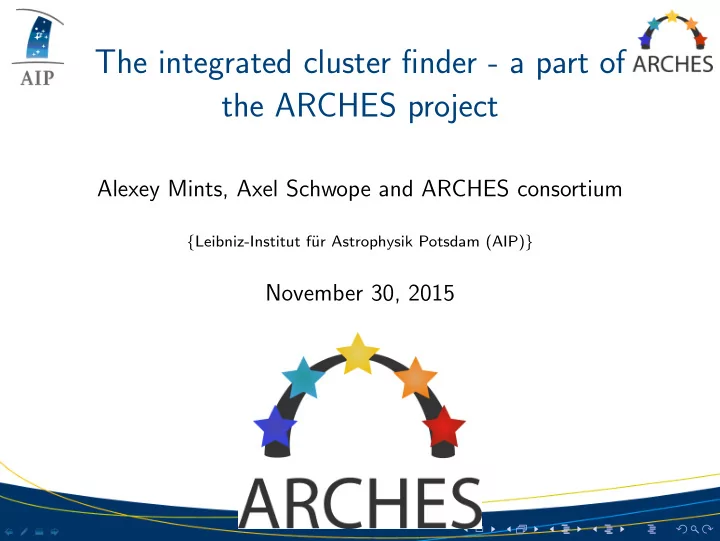

The integrated cluster finder - a part of the ARCHES project Alexey Mints, Axel Schwope and ARCHES consortium { Leibniz-Institut f¨ ur Astrophysik Potsdam (AIP) } November 30, 2015
ARCHES Integrated cluster finder Goal Search for galaxy clusters and estimate their parameters (redshift, sizes) in multi-wavelength photometric and spectroscopic data, using X-ray information on the expected cluster positions.
Catalog table Covered 3XMMe Frequency Number catalogue Area clusters range of objects ( deg . 2 ) overlap Catalogs used AllWISE MIR 41000 747,634,026 1543 UKIDSS JHK 4000 82,655,526 298 SDSS (DR9) ugriz 14555 932,891,133 959 CFTHLS-Wide photo-z 157 35,651,677 149 CFTHLS-Deep photo-z 5.25 2,293,851 38 ALHAMBRA photo-z 4 441,303 18 Spectroscopic catalogs used SDSS-BOSS spec - 859,322 - VIPERS spec - 57,204 -
Cluster finder basics ◮ Use optical AND infrared colors ⇒ we need a cross-match tool (ARCHES Xmatch)
Cluster finder basics ◮ Use optical AND infrared colors ⇒ we need a cross-match tool (ARCHES Xmatch) ◮ Utilize color-redshift relation to estimate redshift, a.k.a. redMaPPer (Rykoff et al., 2014)
Cluster finder basics ◮ Use optical AND infrared colors ⇒ we need a cross-match tool (ARCHES Xmatch) ◮ Utilize color-redshift relation to estimate redshift, a.k.a. redMaPPer (Rykoff et al., 2014) ◮ Use spectral observations to calibrate color-redshift relation
Cluster finder basics ◮ Use optical AND infrared colors ⇒ we need a cross-match tool (ARCHES Xmatch) ◮ Utilize color-redshift relation to estimate redshift, a.k.a. redMaPPer (Rykoff et al., 2014) ◮ Use spectral observations to calibrate color-redshift relation ◮ Estimate background and spurious detection probability
Cluster finder basics ◮ Use optical AND infrared colors ⇒ we need a cross-match tool (ARCHES Xmatch) ◮ Utilize color-redshift relation to estimate redshift, a.k.a. redMaPPer (Rykoff et al., 2014) ◮ Use spectral observations to calibrate color-redshift relation ◮ Estimate background and spurious detection probability ◮ Inputs: position (X-ray source coordinates)
Cluster finder basics ◮ Use optical AND infrared colors ⇒ we need a cross-match tool (ARCHES Xmatch) ◮ Utilize color-redshift relation to estimate redshift, a.k.a. redMaPPer (Rykoff et al., 2014) ◮ Use spectral observations to calibrate color-redshift relation ◮ Estimate background and spurious detection probability ◮ Inputs: position (X-ray source coordinates) ◮ Assumptions: luminosity function, density profile, color-redshift relation...
Color-redshift relation
Limitations of SDSS, UKIDSS and WISE
Cluster membership probability � P ( z , r , m , χ 2 ( z , C )) λ ( z ) = r < R λ – multiplicity; z – redshift, m – magnitude, C – colors, r – distance from the X-ray source; χ 2 – the probability of the galaxy with colors C to have redshift z (incomplete set of colors can be used);
Cluster membership probability λ ( z ) u ( x ) � � P ( x = ( z , r , m , χ 2 ( z , C ))) = λ ( z ) = λ ( z ) u ( x ) + b ( x ) r < R u ( x ) – density profile of the cluster ( NFW ⊗ LF ); Background is tabulated as b ( z , m , χ 2 ); Solved iteratively for λ for each redshift on a pre-defined grid (from 0.02 to 0.8 with a step of 0.01).
Example of λ ( z ).
Spurious detection probability Based on approximation of the distribution of spurious detections in λ and r NFW . Confidence = 1 - p spurious
Validation Tests against other cluster catalogs. Cluster catalogue Number of objects Subset used for testing Reference z range Used objects Recovered Wen and Han 1757 0.16-0.8 524 313 (60%) Wen et al. (2011) Takey et al. 530 0.03-0.7 515 491 (95%) Takey et al. (2013)
3XMMe cluster sample ◮ 1543 extended X-ray sources (from 3XMMe), 850 with SDSS photometry; ◮ Run ICF on these sources: 729 detections; ◮ 509 detections after duplicate removal (361 with spectroscopic redshift); ◮ Select X-ray spectra from XMM archive; ◮ Fit temperature and luminosity for spectra;
Redshift distribution
Products Integrated Cluster Finder server Command-line client for ICFs (Python and bash); ICF web interface (http://serendib.unistra.fr/icf), Hands-on session tomorrow ; Integrated Cluster catalog List of cluster candidates; List of possible cluster members; Associations with other cluster catalogs; Images (SDSS colour + XMM contours);
Thank you for the attention!
Colours
Peak detection
photo-z exp − ( z − z phot ) 2 1 p ν ( z ) = (1) 2 σ 2 � 2 πσ 2 Σ photoz photoz photoz σ 2 δ z 2 phot + 4∆ z 2 = (2) photoz � � � 2 Σ photoz = erf ∆ z (3) σ 2 photoz
Weighted radius The inverse cumulative NFW function F − 1 ( t ) : F − 1 ( F ( r )) = r . �� n i =1 F ( r i ) � r NFW = F − 1 (4) n r NFW ≈ 0 . 5 if members are distributed perfectly at random.
Extra numbers 729 detections in 516 fields 509 detections in 440 fields after duplicate removal (361 (329) with spectroscopic redshift);
3XMMe cluster cuts 1. Observations with high background, hotspots and corrupted mosaic mode data were removed; 2. Low exposure ( < 5ks) observations were removed; 3. 0 < EP EXTENT < 80 arcseconds. This only considers detections with real extent that is below the upper limit of 80 arcsecs imposed in the source detection step within the standard XMM-Newton pipeline processing. 4. EP EXTENT ERR < 10. Excludes poorly constrained extent values. 5. The galactic latitude must satisfy the constraint | b II | > 20 . 3 degrees 6. EP 9 DET ML > 10. Demands a minimum detection likelihood value of 10 in band 9 (XID band = 0.5-4.5 keV) 7. SUM FLAG < 2. Excludes manually flagged detections and also detections with sum flag = 2 – generally detections that are extended and close to other sources or within the envelopes of other extended sources.
Recommend
More recommend